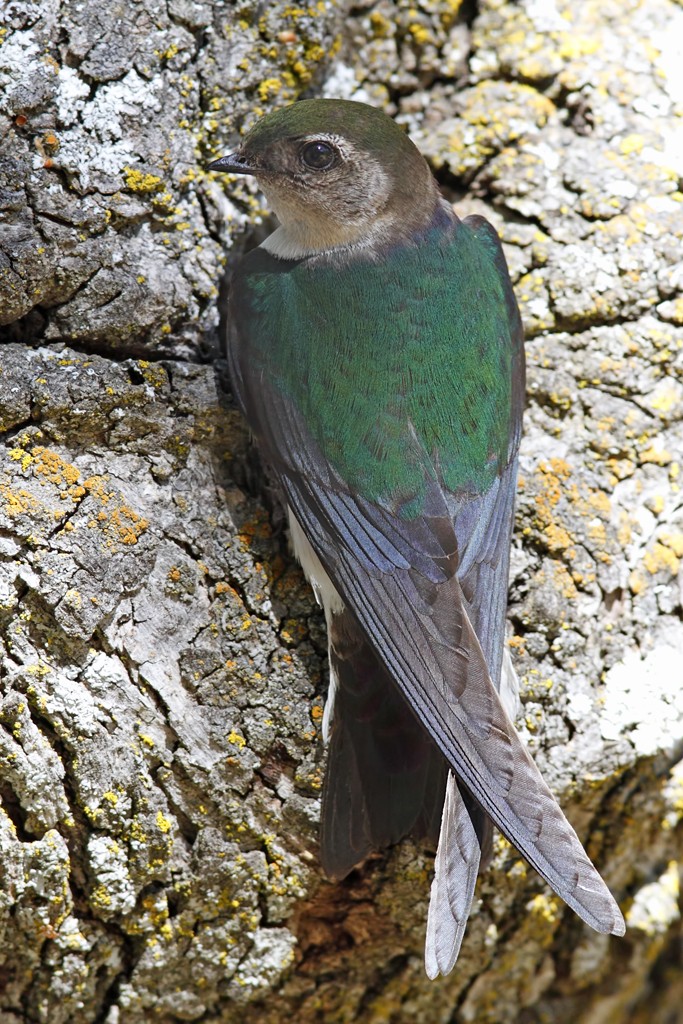Violet-green Swallow
A species of Typical American Swallows Scientific name : Tachycineta thalassina Genus : Typical American Swallows
Violet-green Swallow, A species of Typical American Swallows
Botanical name: Tachycineta thalassina
Genus: Typical American Swallows
Content
Description General Info
Description
The distinct body form of swallows distinguishes them from other passerine birds. Their long pointed wings and slim, streamlined body evolved to catch insects while in flight. The body of the violet-green swallow is no exception. With an average body length of 5¼ in. (13 cm), the violet-green swallow is slightly shorter and appears more compact in flight compared to other members of the family Hirundinidae. The violet-green swallow most closely resembles the North American tree swallow, but can be distinguished by its shorter wings and colouration. 
Size
13-13 cm (5-5.25 in)
Life Expectancy
6.8-7 years
Nest Placement
Cavity
Clutch Size
4 - 6 eggs
Incubation Period
1 - 2 broods
Number of Broods
14 - 15 days
Nestling Period
23 - 24 days
Feeding Habits
Violet-green Swallow's diet consists primarily of flying insects, including flies, leafhoppers, leafbugs, aphids, beetles, and winged ants. They exhibit aerial foraging, catching prey in flight, and can be observed skimming over water and fields, as well as hunting high above the ground.
Habitat
Violet-green Swallow are commonly found in a variety of woodlands, including open deciduous, coniferous, and mixed forests. They favor areas with standing dead trees that offer natural cavities, and often utilize woodpecker holes. These birds inhabit environments from sea level up to elevations of 11,500 feet, adapting to both wildlands and urban areas with suitable nesting sites. Along waterways and near lakes, violet-green Swallow can be observed, while in their nonbreeding season, they range to coastal plains and mountainous regions, including cloud and pine forests up to 10,000 feet in Mexico and Central America.
Nest Behavior
During nest building, which spans a few days to 20, violet-green Swallow may nest solitarily or in colonies, often near water. Egg-laying and parental roles in incubation and feeding the young are shared by both sexes.
Nest Characteristics
Violet-green Swallow typically nest in cavities found in trees, cliffs, or nest boxes, utilizing old woodpecker holes or natural tree cavities. They construct a shallow cup-shaped nest with grass stems, twigs, rootlets, and feathers, about 3 inches across, influenced by cavity size.
Dite type
Insectivorous
General Info
Feeding Habits
Bird food type
Bird Feeder Type

Platform
Sounds
Call
Recording location: United States
Song
Recording location: United States
Behavior
Violet-green Swallow exhibit sociable tendencies throughout the year, forming large foraging flocks with their own species and other aerial insectivores. Their daily activities involve agile flight patterns over various landscapes, such as water bodies and open woodlands, catching insects mid-air with a distinct fluttery motion. They regularly engage in sunbathing and meticulous preening to manage feather parasites. Habitat interactions include competition for nesting cavities with other birds. Reproductive behavior is typically monogamous, though occasional extra-pair copulations occur.
Distribution Area
Violet-green swallows are a predominantly western species, with the rare sighting of individuals in eastern North America. The distribution of the species can be divided based on the recognized subspecies, but the entire range spans from central Alaska down to Mexico. Longitudinally, the range borders the west coast of Alaska, British Columbia and the United States, and extends eastward into southwestern Alberta, Montana, the Dakotas and Texas. The breeding range spans almost the entire distribution, while the winter range is restricted to Mexico. 
Species Status
Not globally threatened.
